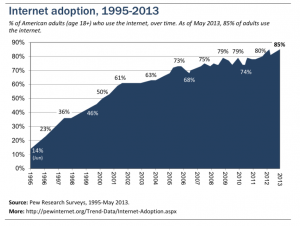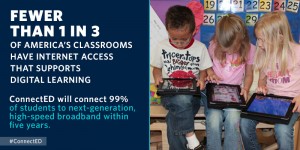What is the Digital Divide?
The Digital Divide is basically a gap in access to information (via the Internet and ICT) between different groups. Groups like the Broadband Commission for Digital Development, the Digital Divide Institute, the Digital Divide Network, and the State Educational Technology Directors Association (SETDA) work in different ways to advocate for equal access to information.
What’s the problem?
 Even though overall Internet use has drastically increased, there is still a divide between high-speed wired broadband access and second-class wireless access because there is virtually no competition in cable/Internet markets. This drives up prices and can even limit access geographically. Access to ICT and Internet is also linked to gender inequality. It is estimated that 200 million more men than women have internet access worldwide.
Even though overall Internet use has drastically increased, there is still a divide between high-speed wired broadband access and second-class wireless access because there is virtually no competition in cable/Internet markets. This drives up prices and can even limit access geographically. Access to ICT and Internet is also linked to gender inequality. It is estimated that 200 million more men than women have internet access worldwide.
Lee Rainie, the director of the Pew Research Center’s Internet and American Life Project breaks down the kinds of people who do not use the Internet and their reasons at the Washington Post Live’s 2013 Bridging the Digital Divide Forum. These factors include race, income levels, and education levels.
How can we close the Digital Divide?
President Obama announced the ConnectED Initiative in June 2013 to “enrich K-12 education for every student in America” by providing broadband access and technology training to connect 99% of students in the U.S. over 5 years.
In “The Broadband Imperative: Recommendations to Address K-12 Education Infrastructure Needs,” the SETDA asserts:
It is a simple fact that access to high-speed broadband is now as vital a component of K-12 school infrastructure as electricity, air conditioning, and heating. The same tools and resources that have transformed our personal civic and professional lives must be part of learning experiences intended to prepare today’s students for college and careers.
The group also makes recommendations about including this tech-ed in K-12 schools. Many of these seem to be covered in President Obama’s ConnectED Initiative.
The Broadband Commission for Digital Development looks at how improved access to ICT and the Internet can also play a part in “advancing gender equality agendas” in their report, “Doubling Digital Opportunities: Enhancing the Inclusion of Women & Girls in the Information Society.” The organization makes several recommendations including boosting the affordability of ICT.



It’s concerning to me that the keys to economic prosperity are increasingly tied to initial wealth. Where is the equality of opportunity when in order to gain access to a higher socioeconomic status you must first be born into it? In order for our democracy to work as intended everyone must have the keys to success and prosperity, and I believe those keys are largely in our public education system. I really hope the ConnectED initiative works as planned.
I wonder how the terms of this discussion would change if we started thinking about high speed internet access as a fundamental human right. This would be a major shift in thinking for the United States.